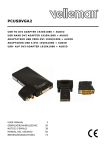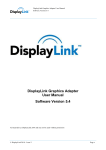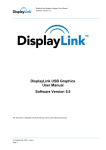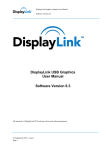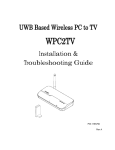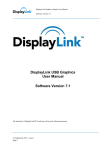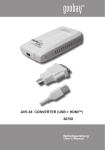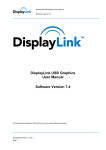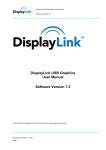Download Cirago UDA2000 User`s manual
Transcript
® VER.5.6 Monitor ,HDTV Projector .... VGA Cable --> Monitor Cable Safety Instructions Always read the safety instructions carefully Keep this User's Manual for future reference Keep this equipment away from humidity If any of the following situation arises, get the equipment checked by a service technician: ·The equipment has been exposed to moisture. ·The equipment has been dropped and damaged. ·The equipment has obvious sign of breakage. ·The equipment has not been working well or you cannot get it work according to User's Manual. Copyright Statement No part of this publication may be reproduced in any form by any means without the prior written permission. Other trademarks or brand names mentioned herein are trademarks or registered trademarks of their respective companies. Disclaimer Information in this document is subject to change without notice. The manufacturer does not make any representations or warranties (implied or otherwise) regarding the accuracy and completeness of this document and shall in no event be liable for any loss of profit or any commercial damage, including but not limited to special, incidental, consequential, or other damage. 1. Introduction Applications Features/ Package Contents System Requirements 2. Hardware Connect 3. Installing the USB Graphics Software To Install the Software on Windows 7 Update To Install the Software on Windows 7/Vista/XP/2000 4. Using the USB Graphics Software Windows 7 - Controlling the Display Windows Vista/XP/2000 – Controlling the Display Windows Vista/XP/2000 – Windows Display Properties 5. USB Graphic Software Update 6. Audio Configure 7. Uninstalling the DisplayLink Graphics Software 8. Additional Information 9. Troubleshooting 10. Mac OS X User Guide 11. Technical Data Overview Note: Menu items and screen selections are shown in italics. 01 02 03 04 05 07 07 08 10 10 14 17 21 23 25 26 30 31 36 1. Introduction Introduction Welcome to use USB Graphics Adapter. It allows you to easily connect extra monitors(TV) to your laptop or desktop PC's USB port. The connected monitors can be configured to either mirror your main screen, or extend the Windows desktop allowing visibility of more applications at the same time. The USB graphics adapter can also be configured to be the primary display The USB Graphics Adapter Software allows full configuration of all additional USB displays, including: ·Support for up to 6 additional USB Displays ·Extended, Mirrored, Primary Display ·Extend left, right, above, or below ·Rotation ·Layout of displays ·Color Depth Applications Office workstation ·View your large spreadsheets across two screens with display continuity ·Multitask more effectively without overlapping windows ·Edit on one screen while surfing the Internet information on the other On the road ·Do multiple screen presentations without bringing another computer ·Easily provide multiple screen exhibitions in a trade show Graphics workstation ·Use second display for palettes/tools ·Get a panoramic view of large documents Editing workstation ·Type documents on one screen while viewing reference material on the other ·Compare two documents simultaneously across two screens Financial analysis ·Have one monitor per data stream ·View charts and live data at the same time Entertainment ·View videos/TV on one screen and reviews on the other ·Get additional perspectives when playing games PAGE·01 PAGE·02 1. Introduction System Requirements Features: ·Can easily Mirror the main display ·Extend left, right, above, or below ·Can be rotated left, right, or upside-down ·USB 2.0 Powered - Ultra Low Power ·CRT, LCD, Projector, TV Displays ·Standard and Widescreen ratio aspects ·Uses a virtual driver ·Stackable by design with a small footprint Model: with Audio output Audio Output Microphone Support Mixed output RCA*2(Left and Right Track) Interface DisplayLink software can be used on PCs, from Netbooks, Notebooks/Laptops to Desktops. The driver will run on processors ranging from Atom N270 based PCs, basic single Core CPUs, and of course the latest Dual, Quad Core and Core i3/i5/i7 CPUs. The performance of the software is dependent upon the processing power available, as well as the operating system in use. More capable systems offer higher performance. Model: HDMI output with audio Output through HDMI cable connect to HDTV Support LCD Monitor or LCD TV with HDMI input. Resolution upto 1080P (1920x1080) DisplayLink software is available for PCs running one of the following Windows operating systems: Note: USB to HDMI Adapter scaling for all HDTV. When TV doesn't scale properly then use the function key (noted: different brand of TV maker may named differently for that function on their remote) from your TV remote to adjust scaling till it return to the proper display. ·Completely silent operation ·Onboard power and status indicator LEDs ·Portable, making it easy for travel Package Contents Before installation, please check the items in the package. The package should contain the following items: ·USB Graphic Adapter ·Driver CD ·USB Cable ·Quick Installation Guide ·DVI to VGA Adapter (Optional) ·DVI to HDMI Adapter (Optional) ·Audio RCA Adapter (Optional) x1 x1 x1 x1 x1 x1 x1 ·Windows 7 (32-bit or 64-bit) ·Windows Vista with Service Pack 1 or 2 (32-bit or 64-bit) ·Windows XP Home or Professional (including Tablet edition) with Service Pack 2 or 3 ·Windows Server 2003, 2008 and 2008 R2 ·Windows 2000 with Service Pack 4 Note: 64-bit editions of XP are not supported. Mac OS X support can be found at http://www.displaylink.com/mac Linux support can be found at http://libdlo.freedesktop.org/wiki/ or http://www.displaylink.org Supported Languages The following languages are supported in version 5.6, on all supported operating systems: Arabic Bahasa Indonesian Bulgarian Chinese (Traditional) Chinese (Simplified) Croatian Czech Danish Dutch English Finnish French Greek Korean German Hungarian Italian Japanese Norwegian Polish Portuguese Russian Slovak Slovenian Spanish Swedish Turkish Unsupported languages default to English. PAGE·03 PAGE·04 2. Hardware Connect Windows 7 / Vista For Windows 7/Vista, the Windows Experience Index (WEI) is a useful measure of hardware level. The WEI is accessible from Computer > Properties, or from Control Panel > System. The recommended typical hardware requirements for the PC are: · WEI score of at least 3 in the 'Graphics; Desktop performance for Windows Aero' category. · Overall WEI score of at least 3 as recommended by Microsoft. · At least one USB 2.0 port · 30 megabytes (MB) of free disk space. · Computer screen for use with the DisplayLink device, if it is not integrated. Windows XP · · · · · · For 1-2 monitors, business usage, productivity target. This may not provide full frame rate DVD playback at full screen: 1.2GHz Single Core CPU, 512MB memory For 3 monitors where 1 could run DVD video while also targeting productivity and business apps. Will support only 1 video of DVD resolution at full screen: 1.6GHz CPU, 1GB memory For 6 screens where 1 screen can run full screen DVD video: 1.8GHz Core Duo, 1GB memory At least one USB 2.0 port, 30 megabytes (MB) of free disk space. Computer screen for use with the DisplayLink device, if it is not integrated. Network access for software downloads, or access to a CD-ROM drive. PAGE·05 Graphics Card Support (Windows Vista/Windows 7) On Windows Vista and Windows 7, DisplayLink software interacts closely with the primary graphics card. DisplayLink support and test a single graphics card (GPU) installed in a PC from all major GPU vendors (Intel, ATI, NVidia and Via) The following GPU configurations may exhibit compatibility issues on Windows 7 and Vista in certain circumstances: · Switchable Graphics (ATI/Intel) · Switchable Graphics (ATI/ATI) · Switchable Graphics (NVIDIA/Intel) · NVIDIA SLI in SLI mode Other GPU configurations, including the following, are currently unsupported and will not function on Windows 7/Vista: · Hybrid Graphics · Hybrid SLI · Hybrid Crossfire · Crossfire · SLI not in SLI mode · Multiple WDDM 1.1 graphics drivers active at once Graphics Card Support (Windows XP) All graphics cards are supported on Windows XP. PAGE·06 2. Hardware Connect Hardware Connect Connect the adapter to your computer and monitor (TV) Connect the smaller end of the USB cable to the adapter. Then connect the other end of the USB cable to an USB 2.0 port on your computer. If your monitor is not yet connected to the adapter, make the connection and power on your monitor VGA connect via DVI to VGA adapter for DVI port product HDMI connect via DVI to HDMI adapter for DVI port product Audio connect * with Audio support product USB Device Connect * with USB port product Connect to CRT, LCD, TV, Project, Speaker, USB ….. USB VGA Connect for VGA port product PAGE·07 DVI connect for DVI port product HDMI connect for HDMI port product PAGE·08 3. Installing the USB Graphics Software Installing the USB Graphics Software Note: The screen may flash or go black during the install. The following section shows you how to install the USB Graphics Adapter software on different operating systems. Note: If you have v3.x, R4.1 or R4.2 DisplayLink software installed you must uninstall it, using the Windows Add/Remove Programs feature, before installing this release. Devices will continue working after this release is installed. To Install the Software on Windows 7 Update The preferred method of installation is using Window 7's Windows Update facility. 1. Connect your UGA device via the USB cable to your PC. Windows detects the new hardware and automatically downloads the driver. To Install the Software on Windows 7/Vista/XP/2000 Alternatively you may install the software from a website download or CD-ROM: Important! Do not connect a UGA device/screen to your PC before the install. 1. Double click on Setup.exe or click from Autorun setup cover page. The Windows User Account Control window opens (if enabled in the OS). 2. Once downloaded, the install will run The DisplayLink software end user licence agreement window opens. 3. Click I Accept. The DisplayLink Core software installs PAGE·09 2. Click Yes. The DisplayLink software end user licence agreement window opens. 3. Click I Accept. DisplayLink Core software and DisplayLink Graphics installs. PAGE·10 4. Using the USB Graphics Software Note: The screen may flash or go black during the install. No message will be shown at the end of the install. 4. Connect your USB Graphic Adapter via the USB cable to your PC. Installing device driver message Using the USB Graphics Software This section describes how to use DisplayLink's Software. The section is divided into sub-sections relating to your operating system. Windows 7 - Controlling the Display On Windows 7, you can configure a UGA device through the use of Windows Display Properties (WDP). WDP provides a simple method to attach, rotate, duplicate or extend screens as well as modify screen resolution. To open WDP The Windows User Account Control window opens. 5. Click Yes. DisplayLink automatically installs the device. The DisplayLink software end user licence agreement window opens (see above). 6. Click I Accept. The DisplayLink graphics software installs, without notification that it has completed. There are several ways to open WDP. 1. Right-click on the desktop. 2. Select Screen Resolution from the menu. 3. WDP opens. OR 1. From Start menu > Devices and Printers. 2. Double-click the DisplayLink Device icon. 3. WDP opens. OR 1. Right click on the DisplayLink icon 2. Click Advanced. 3. WDP opens. Note: On some machines you may need to reboot before you can use your DisplayLink enabled device. Setting the Display Follow this procedure to set the display. PAGE·11 PAGE·12 4. Using the USB Graphics Software To control the Display To set the display 1. Open WDP. 2. Set the display options. Refer to the table below for details on each option. 1. Select the Windows Key + P. The following menu appears. Menu Description Sub-Menu Display Use the drop down list to select a display to be configured. Use the drop down list and user the slider to choose a resolution. Resolution Orientation Multiple displays Landscape Sets the display to landscape view. Portrait Sets the display to portrait mode. Landscape (flipped) Sets the display to upside down landscape mode. Portrait (flipped) Sets the display to upside down portrait mode. Duplicates these displays Reproduces the main display on the second display. Extend these displays Extends the main display onto the secondary display. Show Desktop only on 1 The desktop appears on the display marked 1. The display marked 2 becomes blank. Shows Desktop only on 2 The desktop appears on the display marked 2. The display marked 1 becomes blank. 2. Click on one of the options. The display updates to reflect your choice. Table 1: WDP Options To control the behaviour of an attached DisplayLink display, it is also possible to use Windows Key+P to display a menu (and cycle through it) to switch mode. PAGE·13 PAGE·14 4. Using the USB Graphics Software The DisplayLink Icon Application Windows Vista/XP/2000 – Controlling the Display You can configure the behaviour of the USB Graphics Adapter through the DisplayLink icon application on the taskbar, where present. When devices are attached, an icon appears in the taskbar. This gives you access to the DisplayLink manager menu. To use the DisplayLink Manager Menu To show the DisplayLink Manager menu 1. From the taskbar, click the Show hidden icons arrow to show all available icons. 1. Click the DisplayLink icon on the taskbar. The menu appears as shown below. 2. Click the DisplayLink icon A menu appears with several options, as described in the following table. Menu Description Check for updates Connects to the Windows Update and checks for newer versions and downloads them, if available. Optimize for Video Select this option for better movie playback performance on the DisplayLink enabled displays. Only select this option when playing back video content. Note: Text may appear less clear when enabled. Advanced 2. Select an option from the menu, using the following table for the options available. Opens the Windows Display Properties (WDP) Table 2: DisplayLink menu – Windows 7 PAGE·15 PAGE·16 4. Using the USB Graphics Software Menu Option Sub-menu option Check Now Updates Screen Rotation Extend To Opens the Update Options window where you can configure automatic updates. Medium (16-bit) Displays a list of available resolutions. Some resolutions may be enclosed by [ ]. Please see, Inferred Modes. Changes the colour depth of the extending display to 16 bit Highest (32-bit) Changes the colour depth of the extending display to 32bit Normal No rotation is applied to the DisplayLink display Rotated Left Rotates the extended or mirrored display by 270 degrees. Rotated Right Rotates the extended or mirrored display by 90 degrees. Upside-Down Rotates the extended or mirrored display by 180 degrees. Right Extends the display to the right of the main display. Setting the Display into Mirror Mode Left Extends the display to the left of the main display. In mirror mode, the monitor attached to the USB Graphics Adapter duplicates what is on the primary display. Above Extends the display above of the main display. Below Extends the display below the main display. Extend Extends your desktop onto the secondary display. Set as Main Monitor Sets the secondary display as the main display. Switches off the display of an attached notebook and makes the DisplayLink display primary. Copies what is on the main display and reproduces it on the secondary display. Switches off the secondary display. Configures the secondary display for optimum full screen video performance output. Note: Text may appear less clear. Notebook Monitor Off Mirror Off O p t i m i z e for Video (Vista and Windows 7 Only) Advanced Setting the Display into Extend Mode In extend mode, the monitor attached to the USB Graphics Adapter forms part of the extended Windows desktop. The extra desktop area is a great productivity aid, allowing more applications or documents to be visible at a time. Configure Screen Resolution Color Quality Description Connects to the Update Server to check for newer driver versions and downloads them, if available. Opens the Display Settings window. To set the display into Extend Mode 1. Click on the DisplayLink icon 2. Select Extend. The device is now extended in the direction it was the last time the display was in this mode. For more control, use the Extend To submenu and select one of the options. This puts the device into extend mode, and places it to the Left/Right/Above/Below the main (primary) monitor. To set the display into Mirror mode 1. Click on the DisplayLink icon 2. Select Mirror. The resolution, colour depth and refresh rate of the primary screen are replicated on the monitor connected to the USB Graphics Adapter. If the monitor connected to the USB Graphics Adapter supports a lower resolution than the primary display, then the primary graphics device will have its resolution changed automatically to ensure the whole picture fits on the external screen. Where the monitor connected to the USB Graphics Adapter is of a larger size than the primary screen the image will be letter-boxed to keep the aspect ratio correct. Table 3: DisplayLink Software menu – Windows PAGE·17 PAGE·18 4. Using the USB Graphics Software Windows Vista/XP/2000 – Windows Display Properties You can also configure the USB Graphics Adapters from the Windows Display Properties dialog box. Setting the Display into Extend Mode Use this procedure when you want to extend the Windows desktop to the DisplayLink display. This allows many different applications to be spread over multiple displays, to be able to see multiple applications at the same time. To open the Windows Display Properties on Windows To set the display to Extend Mode using Windows Display properties 1. Right-click on the Desktop. 2. Click Personalize. 3. Click Display Settings. The Display Settings window opens. Select the display to be configured. Its mode, resolution, colour quality and position can all be controlled from here. 1. Select Extend the desktop onto this monitor checkbox (1 in Figure 1). 2. Arrange the screen resolution using the Resolution slide bar. (2) 3. Select the colour quality from the Colors drop-down list. (3). 4. Arrange its position with respect to the other monitors on the extended desktop in using the drag area (4). 5. Click OK to save your changes. For more detailed mode setting, including the refresh rate, click Advanced Settings button, then the Adapter tab then on the List all modes button. All valid combinations of resolution, colour quality and refresh rate are listed. For CRT monitors, it is best to use a high refresh rate so as to avoid discomfort due to flicker. Flat panel monitors do not flicker and a low refresh rate is adequate. To set the display to Extend Mode using the DisplayLink menu 1. From the taskbar, click on the DisplayLink icon 2. Select Extend. Setting the DisplayLink Display to Mirror the Primary Screen Mirror mode copies what is on the main display and reproduces it on the secondary display. To set the display into Mirror Mode 1. Uncheck the Extend the desktop onto this monitor checkbox (1 in Figure 1). 2. Click Apply. PAGE·19 PAGE·20 4. Using the USB Graphics Software To set the display into Mirror mode using the DisplayLink menu 1. From the taskbar, click on the DisplayLink icon 2. Select Mirror. Note: The display resolution of the primary display and the DisplayLink display may be changed to a lower resolution. In mirror mode, both screens must output the same resolution, which may not be the maximum resolution of the display. The USB Graphics Adapter stays primary if the PC enters hibernate or suspend mode or is rebooted. If the USB Graphics Adapter is detached, the main display becomes primary again. To make the USB Graphics Adapter the Primary Display using the DisplayLink menu 1. From the taskbar, click on the DisplayLink icon 2. Select Set as Main Monitor. This mode is NOT recommended if using the DisplayLink display as the primary laptop display, as it is unlikely to provide the optimum resolution for the DisplayLink display. Please see, Setting the DisplayLink display as the Primary Display. Setting a Laptop Lid to do Nothing (Upon Close) Setting the DisplayLink display as the Primary Display To make the USB Graphics Adapter the Primary Display 1. Select the This is my main monitor checkbox (1 in Figure 1). 2. Click Apply. Note: On some PCs and laptops it is necessary to disable the main display (clear the Extend the desktop onto this monitor checkbox for the main display) as part of the same settings change. The reason for this is that many primary graphics card drivers tend to make the laptop screen primary if it is enabled. The only workaround for this is to disable the laptop screen to allow another screen to be primary. To do this: It is possible to work conveniently with a laptop by setting its action on lid closed to ‘do nothing’ then making the USB Graphics Adapter screen primary while disabling the main screen. The laptop lid can then be closed and the laptop used with USB Graphics Adapter screen and with external keyboard and mouse. To set a laptop to do nothing 1. Select Start menu > Control Panel > Power Options. 2. Select Choose what closing the lid does. 3. From When I close the lid, select Do nothing from the On battery and Plugged in drop down list. 1. Select the This is my main monitor checkbox (1 in Figure 1) of the DisplayLink display. 2. Select the primary display (Display 1). 3. Uncheck the Extend the desktop onto this monitor checkbox (1 in Figure 1). 4. Click Apply. PAGE·21 PAGE·22 5. USB Graphic Software Update USB Graphic Software Update On Windows 7, the DisplayLink software connects to the Microsoft Windows update site to obtain the latest DisplayLink driver. On selecting “Check for updates”, the DisplayLink software connects to Windows update, downloads and installs the latest software. Using the Updates Wizard By default, automatic updates is configured to check for updated software on the plugging in of a USB Graphics Adapter, or the resume or start of your PC, every seven days. When newer software is available, the Updates Wizard launches. Manual Updates Automatic Updates DisplayLink Automatic Updates is a product maintenance feature from DisplayLink, supported on Windows 2000/XP and Vista. The automatic update mechanism ensures that the USB Graphics Adapter has the most up-to-date drivers and software, providing you with increased performance and stability. You can check for updates manually at any time. To manually check for updates 1. Click on the DisplayLink icon The DisplayLink menu opens. 2. Select Updates > Check Now. If you have the most recent software, the dialog box, shown below, appears. Otherwise the Choose updates to install dialog opens. You can be disable this feature during install by clearing the Automatically check for updates checkbox. PAGE·23 PAGE·24 6. Audio Configure PAGE·25 PAGE·26 7. Uninstalling the DisplayLink Graphics Software Uninstalling the DisplayLink Graphics Software The method for uninstalling differs slightly depending on your operating system. To uninstall the USB Graphics Adapter on Windows 1. From the Start Menu, select Control Panel. 8.Fit to TV Fit to TV Why do I need Fit to TV? If using your DisplayLink product to connect to a TV, all of the Windows desktop may not be available. This is because TVs can use overscan, which prevents the edges of the image to be visible. When showing a Windows desktop, overscan prevents the edges of the screen being visible, which can hide the task bar and icons. 2. From the Programs item, click Uninstall program. 3. Double click on DisplayLink Core software. A windows confirmation dialog opens (if enabled) 4. Click Yes. 5. A message may appear to state which software packages will also be uninstalled. Click Yes to uninstall the packages that use DisplayLink Core Software. The uninstaller automatically uninstalls the software. 6. Once uninstalled, you will be prompted to reboot Click Yes to complete the uninstall. PAGE·27 Fit to TV can be used to reduce the size of the Windows desktop on the TV screen. Note: Fit to TV only works in extend mode. If choosing the option while in mirror mode, the DisplayLink screen will change to extend and be placed above the laptop screen in Windows Display Properties.Fit to TV does not support rotated modes. Configuration 1. To configure Fit to TV, choose the option from the DisplayLink GUI. The following interface appears 2. You will also see a red border on the DisplayLink screen The red border shows the size of the new Windows desktop. Use the “+” and “-” controls on the Fit to TV GUI to change the size of the red border until it fits on the TV screen. Note: Finer configuration of the size of the border can be achieved by holding down the CTRL key and clicking the “+” and “-”. 3. Once the red border is at the edges of the TV screen, click “Apply” to resize the Windows desktop. PAGE·28 8. Additional Information Additional Information The following section provides additional information on the use of the USB Graphics Adapter software. DirectX 10 Game support This software release contains support for some DirectX 10 games on Windows 7. To improve the gaming experience,it is recommended that: Antialiasing (AA) settings are turned OFF Locking to vsync is turned ON These options are usually configurable within the DirectX 10 game. To play 3D games on a DisplayLink screen with reasonable performance the system specs must meet the game “recommended” hardware specification, not just the minimum specification. Monitor Calibration Monitors can be calibrated with applications that use the Display Data Channel Command Interface (DDC/CI). Both the monitor and application must support DDC/CI for this to work. An example of an application that is now supported is ScreenWhite. DDC/CI is not supported on displays with integrated DisplayLink technology, for example mini monitors. Media Playback On Windows 7, Vista and Windows XP (in extend mode), the USB Graphics Adapter can display media files and DVDs using the following media players: · · · · Windows Media Player 11 (http://www.microsoft.com/windows/windowsmedia/default.mspx) WinDVD 8 (www.intervideo.com) PowerDVD 7 (www.cyberlink.com) RealPlayer 11 (www.real.com) PAGE·29 The USB Graphics adapter can display media files and DVDs using most media players. Media playback in mirror mode (XP) or in Basic mode (Vista and Windows 7) is not recommended. Using Multiple USB Graphics Adapters The software supports up to six simultaneously USB attached screens. It is also possible that different sets of screens are being used at different times, for example two in the office and two at home. The software saves each screen's display profile separately. This allows for different physical positioning, or different resolutions, of connected monitors in the office and the home. Standby and Hibernate, Shut down and Restart If the PC that the USB Graphics Adapter is connected to is placed into standby or hibernate mode, the display goes blank. When the PC is again powered up (and unlocked if necessary) the connected monitor returns to the same mode as it was before stand by or hibernation. If the PC is shut down, restarted and logged in, again the connected display returns to the same mode as it was before shutdown. USB Graphics Adapters with Multiple Users USB Graphics Adapters work with multiple users on the PC. The mode settings are saved for each user so each can use their own desktop configuration. Disconnecting the USB Graphics Adapter If the USB Graphics Adapter is powered off or the USB cable is removed from the computer, the display blanks. All windows and icons move to the primary screen. On reconnection or powering up of the USB Graphics Adapter, the display returns to the same mode as it was before disconnection. However, windows and icons that were previously on the screen will not be moved back. Supported Screen Modes There are three components that make up the screen mode: PAGE·30 Resolution: The number of pixels displayed on screen horizontally and vertically. Color Quality: The number of different colors that can be shown on the screen at the same time. Refresh Rate: The speed that the entire screen is rescanned. Higher refresh rates reduce flicker. Some monitors advertise the supported modes through the VGA or DVI connector. If this is the case, the USB Graphics Adapter identifies the supported modes from the monitor. If the monitor does not advertise the supported modes, the USB Graphics Adapter software chooses a set of common screen modes for the monitor. Inferred Modes Some modes in the DisplayLink GUI are shown with [ ] around them. This occurs when connecting a monitor with a preferred mode higher than the maximum supported resolution of the DisplayLink device In this case, the preferred resolution of the monitor cannot be supported. However we add lower resolutions of the same aspect ratio to be tried with the monitor. Modes in square brackets [ ] imply that these are modes not reported by the monitor, but have been made available by the DisplayLink software for you to try. Error Messages DisplayLink Graphics software occasionally displays user messages in a bubble in the notification area. The table below lists the user messages and their description. Message Description Insufficient system resources exist to complete the requested service This can occur when entering extend mode with low system resources.The PC does not have enough memory to start an extend display. Close down any unused applications. The situation may also be improved by rebooting the PC. The requested allocation size was too large This can occur if trying to mirror a primary display with a resolution above 2300x1700 (4:3) or 2600x1500 (16:9). Incompatible Display Driver This message will appear if the primary graphics card drivers installed are not WDDM compatible. Windows 7 is not designed to operate without WDDM drivers. Download and install the latest Windows 7 (WDDM) drivers for your primary graphics card. The system cannot write to the specified device This warning may be displayed in Windows XP after changing the display mode several times (e.g. Extend/Dock mode) from the DisplayLink GUI. If this happens, detach and reattach the device to restore normal operation. As these are inferred modes from the preferred mode of the monitor, they are not guaranteed to work with the display. PAGE·31 PAGE·32 Further Support http://www.displaylink.com/support . Troubleshooting Minor issues can generally be resolved by: · unplugging and re-plugging the UGA device, · changing the display mode via the DisplayLink GUI, · or changing the display mode via Windows Display Properties. and 10.6(Snow Leopard) On Windows 7/Vista WDDM (Aero and Basic) DisplayLink software works closely with the graphics card and there may be interoperability issues with some graphics cards. If this happens: 1. 2. 3. 4. Try to upgrade to the latest graphics drivers. Try to upgrade to latest DisplayLink software. Report the issue via your support channel. If necessary, boot into Safe Mode and use Windows' Backup and Restore Center to recover. PAGE·33 PAGE·34 PAGE·35 PAGE·36 PAGE·37 PAGE·38 Specifications Host Interface USB 2.0 Video Interface VGA or DVI-I or HDMI Connectivity Up to 6 adapters on a computer RAM 8M x 16 DDR Synchronous DRAM (SDRAM) Power Mode Bus-powered Operation System Support Windows 2000/XP-32Bit, Vista, 7, Server 2003, 2008 and 2008 R2 MAC OS X / Linux Supported Modes Extended Desktop (Default), Mirrored Desktop, Primary Display Color Depth Resolution 640x480, 800x600, 1024x768, 1280x720, 1280x960, 1280x1024, 1360x768,1366x768, 1368x768, 1400x1050, 1440x900 *1600x1200, *1680x1050, *1920x1080, **1920x1200, **2048x1152 Note: that interlaced modes are not supported. * Only supported by 1600x1200 model. ** Only supported by 1900x1200 model. Operating temperature 10-40°C Storage temperature -10~80°C Relative Humidity < 85%non-condensing * Specifications are subject to change without notice. PAGE·39






















